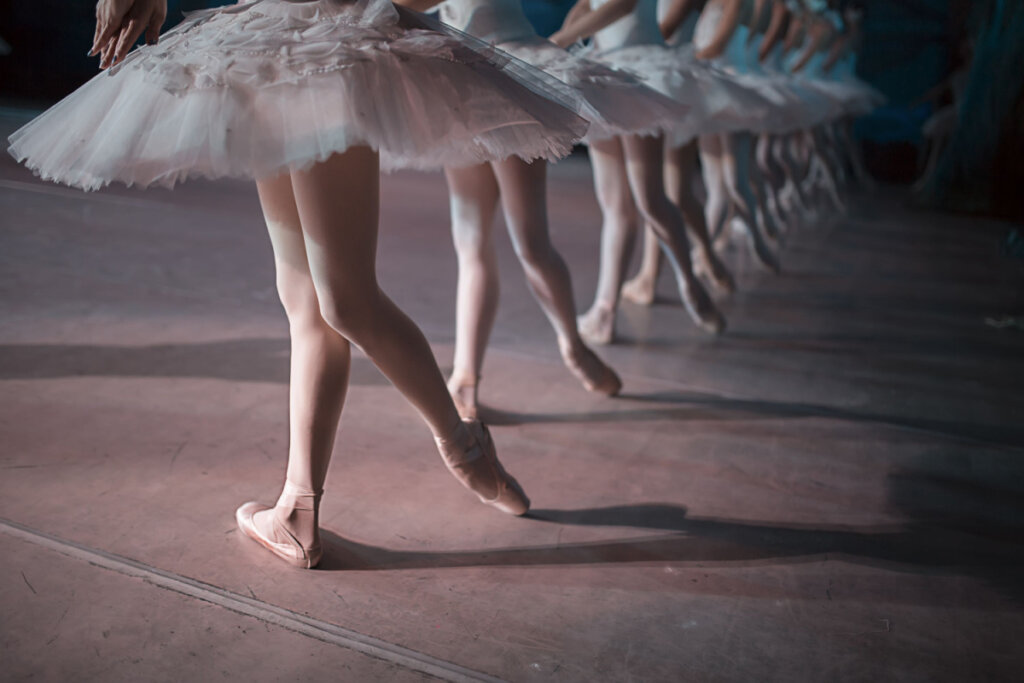Some Curious Facts About Dance

Dance, as a channel of spontaneous expression, has a history almost as long as that of humankind. Indeed, ever since our arrival as a species, we’ve used our bodies to express our ideas and emotions. Like other artistic manifestations, over time, dance has evolved and become part of many collective rituals, both sacred and profane.
However, human beings aren’t the only animals that use dance to express themselves. In fact, there are several species that use movements that could certainly be described as harmonic, especially during courtship rituals. Nevertheless, it’s only in humans that the practice has evolved into an art that almost magically exploits the dynamic possibilities of the body.
Ancient Greece was the first culture to view dance as an artistic activity. It was also the first to combine it with the theater. Socrates is said to have been praised by his contemporaries because he danced beautifully. On the other hand, Plato didn’t have any rhythm and had no desire to learn how to dance, for which he received a lot of criticism.
“The dance can reveal everything mysterious that is hidden in music, and it has the additional merit of being human and palpable.”
-Charles Baudelaire-

Some curious facts about dance
Speaking of Plato, this great philosopher but lousy dancer still found time to address the subject of dance. He claimed that there were three types: imitative, athletic, and suspicious. The first was typical of social life and he considered it to be decorous. The second sought maximum grace in the body. However, he thought the third kind encouraged drunkenness and excess and believed it should be prohibited.
In Ancient Rome, there was one extremely curious dance. When someone died, a person took the dress of the deceased and covered their face with a mask. They stood in front of the funeral procession and their role was to represent the habits and actions of the deceased, without saying a word. In effect, they let their body speak.
During the Middle Ages, there was a decline in dance. In fact, it only regained importance in the Renaissance. The first known dance academy was opened in France in 1661, sponsored by Louis XIV, the Sun King. In Africa and the Americas, dance was a common expression and was linked both with religious and social life.
Curious facts about ballet
Ballet is the most recognized artistic expression of dance. It was born in Renaissance Italy but reached its splendor in France. Almost from its beginnings, the five basic positions were developed, and they remain in force to this day. The most famous works are Swan Lake, The Nutcracker, and The Sleeping Beauty, all choreographed by Marius Petipa, a Frenchman who lived most of his life in Russia.
There are two elements of ballet that are almost mythical: the famous tutu and the ballet shoes. In its early days, the tutu was flexible and reached the ankles. It was thought that by using this garment the dancers would look as if they literally, were flying across the stage. Sadly, the early tutus favored by dancers weren’t usually fireproof and on July 26, 1862, Emma Livry’s tutu caught fire on stage and she was badly injured. She later died from her wounds.
As for ballet shoes, contrary to what many think, they don’t have plaster toes but are made of cardboard and cloth. Interestingly, the feet of those who practice ballet are so strong that when they jump and land they can support up to three times their own weight.

Dance, a fantastic universe
Professor Tomoyuki Yamamoto, from the Advanced Institute for Science and Technology in Japan, conducted a study in which he concluded that soccer players who know how to dance the samba improve their skills significantly Does this explain the success of the Brazilian soccer team, or do they simply naturally possess rhythm in their bodies?
Another study conducted by The University of Missouri (USA), claimed that dance is of great benefit to the elderly. In particular, it helps to improve their balance. For this reason, it’s a splendid safeguard against falls, which are so common in older people. In addition, dancing oxygenates the blood and keeps the brain active.
Dance has also been used as a therapeutic means in other ways. In fact, research indicates that it’s an excellent supplement to relieve the side effects of some treatments, such as those for cancer. It also reduces depression, anxiety, and fatigue, while reducing the perception of pain. What an extraordinary activity.
Dance, as a channel of spontaneous expression, has a history almost as long as that of humankind. Indeed, ever since our arrival as a species, we’ve used our bodies to express our ideas and emotions. Like other artistic manifestations, over time, dance has evolved and become part of many collective rituals, both sacred and profane.
However, human beings aren’t the only animals that use dance to express themselves. In fact, there are several species that use movements that could certainly be described as harmonic, especially during courtship rituals. Nevertheless, it’s only in humans that the practice has evolved into an art that almost magically exploits the dynamic possibilities of the body.
Ancient Greece was the first culture to view dance as an artistic activity. It was also the first to combine it with the theater. Socrates is said to have been praised by his contemporaries because he danced beautifully. On the other hand, Plato didn’t have any rhythm and had no desire to learn how to dance, for which he received a lot of criticism.
“The dance can reveal everything mysterious that is hidden in music, and it has the additional merit of being human and palpable.”
-Charles Baudelaire-

Some curious facts about dance
Speaking of Plato, this great philosopher but lousy dancer still found time to address the subject of dance. He claimed that there were three types: imitative, athletic, and suspicious. The first was typical of social life and he considered it to be decorous. The second sought maximum grace in the body. However, he thought the third kind encouraged drunkenness and excess and believed it should be prohibited.
In Ancient Rome, there was one extremely curious dance. When someone died, a person took the dress of the deceased and covered their face with a mask. They stood in front of the funeral procession and their role was to represent the habits and actions of the deceased, without saying a word. In effect, they let their body speak.
During the Middle Ages, there was a decline in dance. In fact, it only regained importance in the Renaissance. The first known dance academy was opened in France in 1661, sponsored by Louis XIV, the Sun King. In Africa and the Americas, dance was a common expression and was linked both with religious and social life.
Curious facts about ballet
Ballet is the most recognized artistic expression of dance. It was born in Renaissance Italy but reached its splendor in France. Almost from its beginnings, the five basic positions were developed, and they remain in force to this day. The most famous works are Swan Lake, The Nutcracker, and The Sleeping Beauty, all choreographed by Marius Petipa, a Frenchman who lived most of his life in Russia.
There are two elements of ballet that are almost mythical: the famous tutu and the ballet shoes. In its early days, the tutu was flexible and reached the ankles. It was thought that by using this garment the dancers would look as if they literally, were flying across the stage. Sadly, the early tutus favored by dancers weren’t usually fireproof and on July 26, 1862, Emma Livry’s tutu caught fire on stage and she was badly injured. She later died from her wounds.
As for ballet shoes, contrary to what many think, they don’t have plaster toes but are made of cardboard and cloth. Interestingly, the feet of those who practice ballet are so strong that when they jump and land they can support up to three times their own weight.

Dance, a fantastic universe
Professor Tomoyuki Yamamoto, from the Advanced Institute for Science and Technology in Japan, conducted a study in which he concluded that soccer players who know how to dance the samba improve their skills significantly Does this explain the success of the Brazilian soccer team, or do they simply naturally possess rhythm in their bodies?
Another study conducted by The University of Missouri (USA), claimed that dance is of great benefit to the elderly. In particular, it helps to improve their balance. For this reason, it’s a splendid safeguard against falls, which are so common in older people. In addition, dancing oxygenates the blood and keeps the brain active.
Dance has also been used as a therapeutic means in other ways. In fact, research indicates that it’s an excellent supplement to relieve the side effects of some treatments, such as those for cancer. It also reduces depression, anxiety, and fatigue, while reducing the perception of pain. What an extraordinary activity.
All cited sources were thoroughly reviewed by our team to ensure their quality, reliability, currency, and validity. The bibliography of this article was considered reliable and of academic or scientific accuracy.
- Iguchi, J., Yamamoto, T., & Fujinami, T. (2006). Samba helps football players improve their skill. Journal of Biomechanics, (39), S556.
- Krampe, J. (2013). Explorando los efectos de la terapia basada en la danza sobre el equilibrio y la movilidad en adultos mayores. Revista occidental de investigación de enfermería, 35 (1), 39-56.
- Markessinis, A. (1995). Historia de la danza desde sus orígenes. Lib. Deportivas Esteban Sanz.
- Sebiani, L. (2005). uso de la danza-terapia en la adaptación psicológica a enfermedades crónicas.(cáncer, fibrosis, sida). Reflexiones, 84(1), 49-56.
This text is provided for informational purposes only and does not replace consultation with a professional. If in doubt, consult your specialist.







